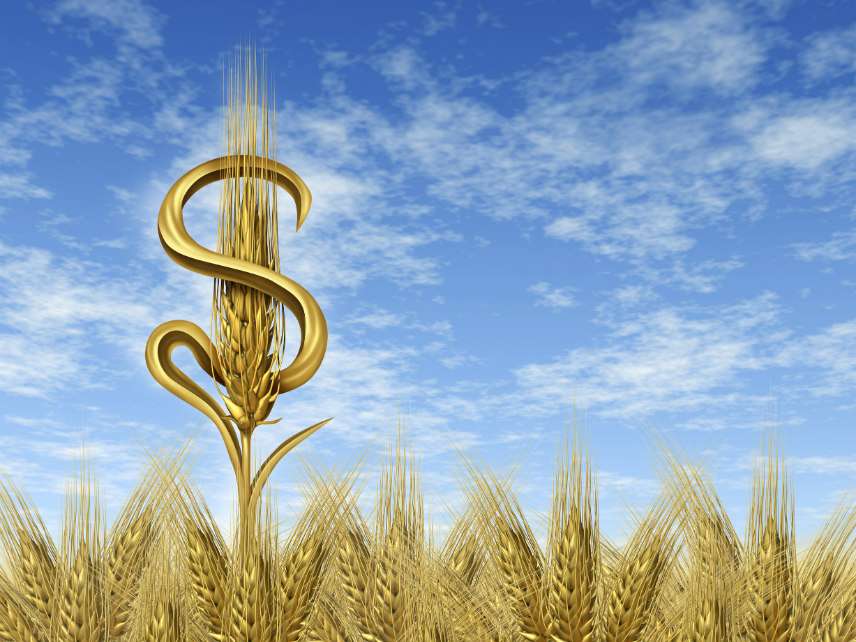New Farm Subsidy Programs Were Supposed to Save Money; Instead They've Cost Billions More Than Predicted
Most of the money has gone to a small collection of well-off farms.

The government tends to be terrible at pruning back spending. For evidence, consider the new form of farm subsidies it adopted in 2014—a reform that was supposed to save taxpayers' money but instead is costing us billions more than projected.
According to new analysis by the Environmental Working Group, the government spent $8.8 billion last year on commodity subsidies, paid to the growers of corn, wheat, soy, and other crops. That's about twice the $4.8 billion the feds had anticipated its commodity programs would cost.
As with past subsidy schemes the bulk of these billions are going not to small family farms but to the largest, most prosperous agribusinesses. In 2016, the top 1 percent of subsidy recipients were getting a minimum $116,501 payout, while the median recipient was recieving only $2,479.
"When you look the current subsidy system," says Colin O'Neil, legislative affairs director for Environmental Working Group, "we are seeing a concentration of wealth with the largest, most successful farm businesses."
The 2014 Farm Bill eliminated the government's system of direct payments to farmers, a change that was supposed to scale back spending and spread the subsidy benefits around more evenly. At the time, those direct payments had become a national embarrassment: A 2012 report by the Government Accountability Office found that a quarter of payments were going to producers who were not even growing the crops the program was supposed to subsidize, while another 2,300 farms were getting subsidies while growing no crops at all.
"Everyone knew that the program that previously existed, the direct payment program, was going to go away," says Josh Sewel of Taxpayers for Common Sense. So the discussion between Congress and farm lobbyists became one of how to scrap the direct payments without losing the money attached to it.
They settled on the new Agricultural Risk Coverage (ARC) program, which would pay farmers a subsidy whenever the revenue for their crops fell below a five-year average revenue set by Congress. They also created a smaller Price Loss Coverage (PLC), which pays out if prices fell below a particular point. This, proponents argued, would save taxpayers money by only funding farmers when their revenue saw a sudden drop.
The Congressional Budget Office (CBO), working with revenue and price projections provided by Congress, estimated that these new subsidy schemes would cost $2.5 billion in 2015 and then only about $4.8 billion in 2016—almost a $1 billion less than what the direct payments would have cost.
Instead, the new programs paid out $5.7 billion in 2015 and a staggering $8.82 billion in 2016, a combined cost overrun of $7.2 billion. "It has cost us a lot more money than if we had just kept paying farmers to be farmers," says Sewel.
When Congress drafted the 2014 Farm Bill, lawmakers predicted that crop prices and revenue would remain at historic highs, necessitating little in the way of payouts. When those predictions proved wildly overoptimistic, the costs of the new programs skyrocketed.
Those overruns are set to continue. According to a budget analysis released by the CBO in June, the new system of commodity subsidies will cost $22.1 billion from 2016 to 2018—$7.5 billion more than predicted.
The new subsidy arrangements have not been more equitable either, with huge cash payments still going to the large agricultural producers. In 2016, the largest recipient of commodity subsidies was Deline Farm Partnership, which operates farms across six states and received a $4 million payout from the federal government.
These programs are set to expire in 2018. When Congress takes up the issue again, Sewel hopes it will recognize that ARC and PLC have been failures.
Not only are they "overgenerous" and "unnecessary," he says, but they also distort the market forces the agricultural industry relies on to spur change and productivity growth.
"People tend to forget that farmers are some of the most innovative, dynamic, technically expert" producers, Sewel tells Reason. "There is a lot of innovation that can happen there if they're given the opportunity."
Rent Free is a weekly newsletter from Christian Britschgi on urbanism and the fight for less regulation, more housing, more property rights, and more freedom in America's cities.


Show Comments (22)